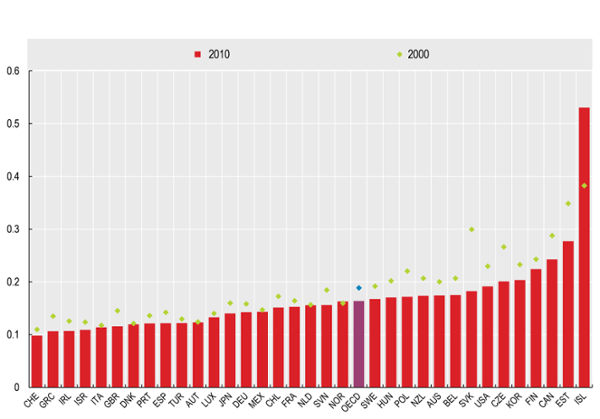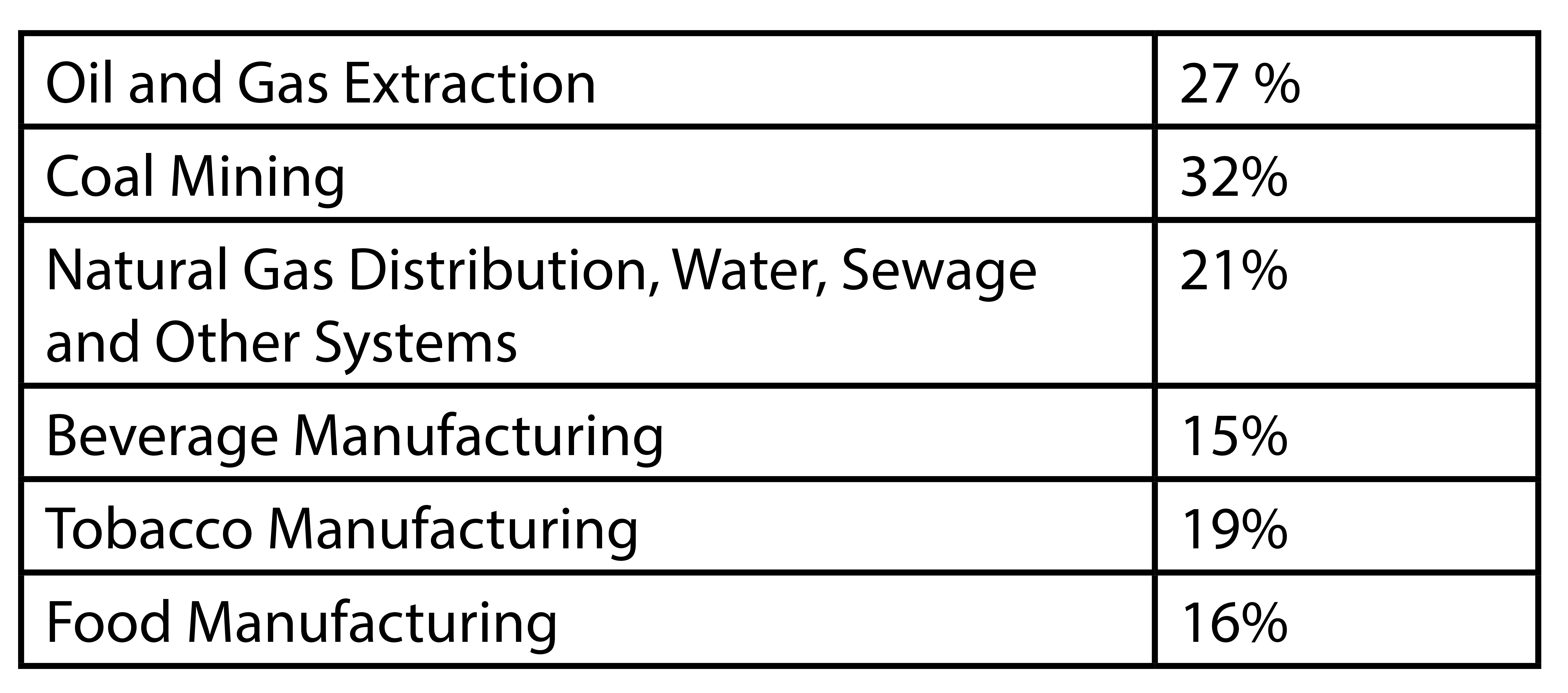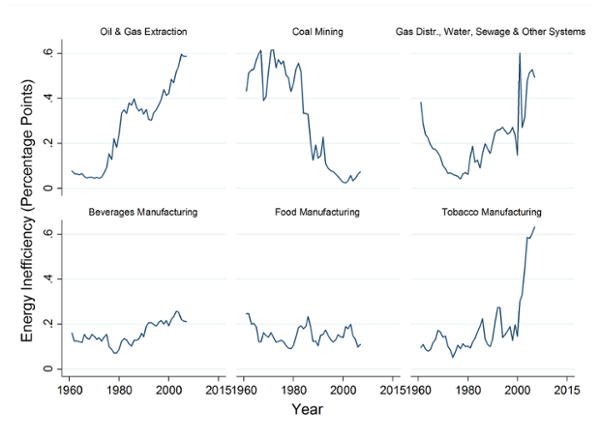
Energy inefficiency of Canadian goods producing industries: Policy opportunities
Canadians face a daunting challenge. The Government of Canada has committed to reducing emissions of carbon dioxide (CO2) to 522.9 million tonnes by 2030, a 32 per cent reduction from current levels. In 2014 Canada emitted 7681 million tonnes of CO2, which means Canadians will be required to reduce emissions by 245.1 tonnes to meet this objective. Given the magnitude of the challenge, it’s critical to recognize the reality Canada faces. There are really only two ways Canadians can meet the national target - by reducing energy inefficiency, or by reducing their material standard of living. In this Policy Brief, we explore the potential for reducing CO2 emissions by eliminating inefficiency.
By Jason Childs; Samuel GamtessaCanadians face a daunting challenge. The Government of Canada has committed to reducing emissions of carbon dioxide (CO2) to 522.9 million tonnes by 2030, a 32 per cent reduction from current levels. In 2014 Canada emitted 7681 million tonnes of CO2, which means Canadians will be required to reduce emissions by 245.1 tonnes to meet this objective. Given the magnitude of the challenge, it’s critical to recognize the reality Canada faces. There are really only two ways Canadians can meet the national target - by reducing energy inefficiency, or by reducing their material standard of living. In this Policy Brief, we explore the potential for reducing CO2 emissions by eliminating inefficiency.
As a starting point, it’s important to acknowledge that reducing CO2 emissions has the potential to do more damage to Canadians’ standard of living than to most other wealthy countries. Why? Canada’s economy is heavily dependent on energy both in production and consumption. As Figure 1 shows, Canada’s economy is the third most energy intensive in the Organization for Economic Cooperation and Development (OECD).

A successful policy to reduce greenhouse gas emissions, while minimizing the impact on living standards, depends on the ability of energy consumers to reduce inefficiency rather than output (and therefore incomes). To understand whether a policy is likely to cause a reduction in inefficiency or a reduction in output - assuming it meets its emissions reduction objective - accurate estimates of energy inefficiency are needed.
The goods-producing sector of the Canadian economy, which accounts for 30 per cent of GDP2, will be particularly challenged in meeting our climate-change objectives, as it produced 473.8 million tonnes of CO2 or 61.7%3 of Canada’s emissions in 2014. We use the estimates produced by Gamtessa and Childs (2016) to assess the reduction in emissions possible without reducing output given currently available technology.
What makes the economic challenge even greater for Canada has been the election of President Donald Trump, who appears determined to reverse course on efforts by the former Obama administration to reduce U.S GHG emissions. As Canada’s most important trading partner and our two economies deeply integrated, the divergent U.S. approach will create economic competitive issues for Canada.
Estimating Current Energy Inefficiency
We (Childs and Gamtessa, 2016) estimate energy inefficiency – deviation from best practice - of the goods-producing sector of the Canadian economy using advanced econometric methods. While this work produces estimates of inefficiency of the 33 goods producing industries in the goods-producing sector, here we focus on just six: beverage manufacturing, coal mining, oil and gas extraction, tobacco, food processing, and finally natural gas, water, sewage and other systems.
The sector-wide and industry-specific inefficiency estimates are shown in Figure 2.

The overall average inefficiency of this sector of the economy is 19%, ranging from a low of 15% in beverage manufacturing (0.3% of GDP) to a high of 32% in coal mining (0.1% of GDP). Oil and gas extraction (6.1% of GDP) is also found to be highly inefficient, with an estimated inefficiency of 27%4.
Energy inefficiency is not static over the period in question. Figure 3 shows the changing inefficiency of each industry. It is worth noting the different experiences of oil and gas extraction and coal mining during the past 50 years. Coal mining has seen the closure of many inefficient operations, and, as a result, there are just 19 mines currently producing in Canada. Oil and gas extraction has seen an expansion in the number of productive sites and has moved into producing from more energy-intensive reserves. The energy required to extract crude oil from oil sands is much higher than running a pump jack on conventional reserves, which results in a higher estimate of inefficiency.
The tobacco industry’s recent experience adds another element to understanding the evolution of energy inefficiency. As the industry has seen increased regulation and falling demand for its product, it has also seen its energy inefficiency rise, likely due to a lack of investment.

Rising inefficiency in the natural gas, water, sewage, and other systems sector (0.5% of GDP) also warrants comment. As with the tobacco industry, distribution infrastructure in Canada suffers from under investment which raises inefficiency. The Federation of Canadian Municipalities estimates a total of $61 billion is needed to replace potable water, waste water, and storm water systems in poor or very poor conditions across the country (Federation of Canadian Municipalities, 2016). In comparison to these industries, food manufacturing (1.4% of GDP) has seen relatively little change in inefficiency since the 1960s. Relatively small waves of decreasing and increasing efficiency seem to represent the norm. The pattern of energy inefficiency is roughly consistent with the growthof investment in the industry (Beaulieau & Trant, 2012), which offers a general lesson that reduced inefficiency requires increased capital investment.
These estimates indicate ample opportunity for the Canadian goods-producing sector to reduce energy consumption without reducing output, providing there is sufficient new investment. However, the evolution of inefficiency in different industries during the previous 50 years indicates policy inventions must consider the context of individual industries to understand the likely impact of policy.
Energy Inefficiency and Prices
Inefficient use of energy by goods producers is typically the result of a trade-off between the capital and other costs of reducing energy use and the price of energy. Under the current policy regime and energy prices, significant inefficiency remains and additional policy interventions may be required to induce firms to reduce inefficiency. Permanently increasing the price of energy with a carbon price is one option.
To underscore the carbon-price option, our research shows the impact of permanent changes in energy price on energy inefficiency across the goods-producing sector and finds energy inefficiency clearly falls as the price of energy rises. The elasticity of inefficiency with respect to cumulative increases in energy price (calculated at means) is -0.66, which indicates a permanent 10 per cent increase in the price of energy will reduce remaining energy inefficiency by at most 6.6 per cent. To be clear, if energy prices permanently increase by 10 per cent, energy inefficiency in the goods-producing sector will fall from 19 per cent to 17.75 per cent.

The imposition of a carbon price of $50 a tonne would raise the price of energy by approximately 12%5 and result in reductions of 8.6 million tonnes of CO2 emissions in the goods-producing sector. While this reduction in emissions will contribute to meeting Canada’s COP 21 commitment it leaves 142.6 million tonnes of CO2 emission reductions to be made by the goods-producing sector through either reductions in output (and therefore losses of wages and jobs) or improvements in technology.
Additional Policy Options
To address this shortfall in reductions, a mix of policies richer than just a carbon price is needed. We set out four noncarbon price options for policy to further support reductions in greenhouse gas emissions for Canada.
Support Dissemination of Best Practice
Federal and provincial governments can enhance their partnership with industry under the Canadian Industry Program for Energy Conservation (CIPEC) to spread best practice among firms. The Energy Management Leadership Awards program can be enhanced to induce more competition in energy efficiency between firms.
Direct funding of research and development through to commercialization
Technological advance reduces the amount of energy and carbon dioxide emissions associated with a given level of output. Without further technological improvement the only way to meet Canada’s COP21 targets is to reduce Canadians’ standard of living. Currently, the majority of emitters do not have the financial or technical capacity to develop new technologies in-house, meaning new technology must be developed elsewhere. The Canadian University system continues to offer world-class research capacity in this regard, and a series of targeted grants would further leverage this innovative capacity.
However, universities have less experience and capacity for the commercialization of new technology, though this capacity is improving. Thus, further support for private sector-university partnerships to see technology from theinvention/innovation stage through to deployment in a commercial setting will dramatically improve Canada’s ability to reduce emissions.
By supporting the development of new technology, Canadian governments can have an impact on global warming far larger than by simply meeting our COP21 commitments. The development and commercialization of new emissions reducing technology will allow Canadian emitters, as well as those in other jurisdictions, to reduce their carbon footprint without sacrificing living standards.
Transition support/funding for the adoption of new technology
Many technological improvements are embedded in capital equipment, thus in order to adopt new technology existing capital must be replaced. Firms are often reluctant to replace capital until it has been fully depreciated for tax purposes. Direct subsidies for firms adopting new cleaner technology or accelerated depreciation for existing technology, when more energy efficient technology exists, will facilitate this transition and increase the impact of any carbon-pricing policy on firm level efforts to reduce inefficiency.
New technology and the associated capital equipment often require different skills to utilize properly. To facilitate the adoption of new technologies that are functionally different from those widely employed will require training or retraining of workers.
Innovation competitions
The success of “X-prize” competitions, such as those for oil clean up and reusable orbital vehicles6 have led to dramatic improvements in technology and major steps toward the implementation of this technology in a short period of time. These competitions offer a substantive cash prize to the first organization to meet a well-defined objective. The X-prize organization is currently hosting a competition over transforming CO2 into building materials, biofuels, and even hygiene products. A similar competition offered in partnership with industry and tailored to the needs of Canadian industry and households would leverage the innovative capacity of both the university sector and the private sector to develop deployable technology to reduce Canadian carbon emissions.
A combination of all four of these policies will likely be needed if Canada is meet its COP21 targets without a harmful reduction in material standards of living. The current carbon price-focused policies are likely to bring about regressive reductions in income and employment, while being unlikely to meet our international commitments.
References
Beaulieau, M., & Trant, M. (accessed 2017, January 13). Canadian food processing industries: Structure and recent changes. Retrieved from Statistics Canada: http://www.statcan.gc.ca/pub/61-532-x/1997001/article/3504-eng.html
Federation of Canadian Municipalities. (2016, September 6). Canadian Infrastructure Report Card 2016. Retrieved from Federation of Canadian Municipalities: http://www.canadainfrastructure.ca/downloads/Canadian_Infrastructure_Report_2016.pdf
Gamtessa, S., & Childs, J. (2016). Assessing the Potential Energy Efficiency of Canadian Industry. Working Paper.
Greene, W. (2005a). Fixed and random effects in stochastic frontier models. Journal of Productivity Analysis, 7-32.
Greene, W. (2005b). Reconsidering heterogeneity in panel data estimators of the stochastic frontier model. Journal of Econometrics, 269-303.
Murray, B., & Rivers, N. (2015). British Columbia’s Revenue-Neutral Carbon Tax: A Review of the Latest “Grand Experiment” in Environmental Policy. Nicholas Institute Working Paper - NIWP 15-04.
Jason Childs

Jason Childs is an Associate Professor of Economics at the University of Regina. His primary research area is experimental and behavioural economics. Increasingly his work concerns the application of economic research to improve public policy.
Samuel Gamtessa

Samuel Gamtessa has a PhD in economics from the University of Alberta and is currently an assistant professor in the Department of Economics at the University of Regina. His research is mainly focused on energy efficiency and climate change policies. He also researches production efficiency and productivity growth.
People who are passionate about public policy know that the Province of Saskatchewan has pioneered some of Canada’s major policy innovations. The two distinguished public servants after whom the school is named, Albert W. Johnson and Thomas K. Shoyama, used their practical and theoretical knowledge to challenge existing policies and practices, as well as to explore new policies and organizational forms. Earning the label, “the Greatest Generation,” they and their colleagues became part of a group of modernizers who saw government as a positive catalyst of change in post-war Canada. They created a legacy of achievement in public administration and professionalism in public service that remains a continuing inspiration for public servants in Saskatchewan and across the country. The Johnson Shoyama Graduate School of Public Policy is proud to carry on the tradition by educating students interested in and devoted to advancing public value.
View Publication
